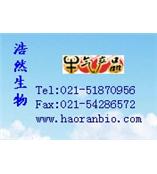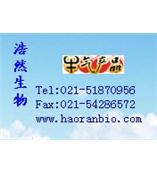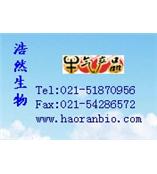来宝网 2011/7/12点击2549次
上海浩然生物技术有限公司
订购电话:021-51870956
在线QQ:470003480
细胞分离液 Percoll
Percoll不连续密度梯度沉淀法分离纯化淋巴细胞和淋巴母细胞
(一) 原理
Percoll是一种包有乙烯吡咯烷酮的硅胶颗粒。渗透压很低(<20mosm/kg H2O)'' 粘度也很小,可形成高达1.3g/ml密度,采用预先形成的密度梯度时可在低离心力(200~1000g)于数分至数十分钟内达到满意的细胞分离结果。由于Percoll扩散常数低,所形成的梯度十分稳定。此外,Percoll不穿透生物膜,对细胞无毒害,因此广泛用于分离细胞、亚细胞成分、细菌及病毒,还可将受损细胞及其碎片与完好的活细胞分离。
(二)操作方法及注意事项
1.不同浓度(密度)Percoll溶液的制备: 先用9份Percoll与1份8.5% NaCl或1.5MPBS混合达到生理性渗透压,然后用生理溶液(0.85% NaCl或0.15M PBS)稀释到所需浓度。
Percoll浓度(%) 70 60 50 40 30 20
比重g/ml 1.090 1.077 1.067 1.056 1.043 1.031
2.不连续密度梯度Percoll层的制备: 先将试管壁用牛血清湿润,除去多余血清,这种预处理可使逐层叠加的Percoll液平稳沿管壁流下,使形成满意的界面。在制备过程中一般用长针头注射器从高密度向低密度逐层放置,有时相邻两层Percoll比重相差不大时,可将Percoll液放入注射器中,小针头斜面紧贴管壁,任其自然慢慢流下。
3.装样:样品体积和细胞浓度根据不同细胞而异,一般加样体积不宜过大,细胞浓度也不可过高,否则会影响细胞的分离和回收。
4.离心:一般采用离心力为400g,时间20~25min。由于多层Percoll之间密度差别不大,因此离心机加速、降速时要慢,要平稳。
5.取样:当所要分离的细胞绝大部分在两层的界面时,可逐层去除Percoll液后收集界面部位的细胞;有时大部分细胞位于Percoll层中''则需要逐层收集。收获含有Percoll液的细胞经2次洗涤后可供培养或检测用。
(三)分离纯化细胞举例
1.富含NK活性大颗粒淋巴细胞(LGL)的纯化:按顺序由下向上逐层加50%、47.5%、45%、42.5%和40%五种不同密度的Percoll''如用10ml试管(或塑料管)分离''每层Percoll约1.2~1.5ml,初步从外周血中分离的PBMC细胞1×108悬于1ml培基中,按要求装样、离心和取样。一般富含NK杀伤活性的LGL细胞位于42.5%与45%Percoll界面以及上下二层的Percoll液中。
2.纯化淋巴母细胞和除去死细胞:分别叠加50%和30%Percoll液。收取经PHA(或其它抗原、有丝分裂原)刺激PBMC''或含有较高比例异型的PBMC(如肾综合征出血热患者),按要求装样、离心和取样。位于管底的淋巴细胞为小淋巴细胞;两层Percoll之间为淋巴母细胞,纯度和回收率在80%以上,位于30%Percoll表面是死细胞。收获淋巴母细胞可进行表型、结构以及功能的研究。
(四) 人不同血细胞的漂浮密度
表 人不同血细胞的漂浮密度
──────────────┬──────────────────
细 胞 漂浮密度 │ 细 胞 漂浮密度
──────────────┼──────────────────
红细胞 1.09-1.11 │淋巴细胞 1.052-1.077
粒细胞 │ B淋巴细胞 1.062-1.075
嗜酸性 1.09-1.095 │ T淋巴细胞 1.065-1.077
嗜中性 1.080-1.085 │ 淋巴母细胞 1.065-1.077
单核细胞 1.050-1.066 │自然杀伤细胞 1.050-1.070
血小板 1.030-1.060 │
──────────────┴──────────────────
(五)问与答
问:请问percoll连续梯度怎么配制?比如15%---75%的percoll连续梯度?
答:根据你需要的具体密度梯度决定的,根据要分离的不同细胞种类,数量等等,也有用原液配的。也有用80%配的,不一定的。另外,percoll本身是低渗透压的,要用高渗透压溶液配成生理等渗透压溶液,然后使用,不然,细胞容易破裂。一般是先用9份Percoll与1份8.5% NaCl或1.5MPBS混合达到生理性渗透压,然后用生理溶液(0.85% NaCl或0.15M PBS)稀释到所需浓度。即取Percoll原液与10倍浓缩的PBS以9:1的比例混合,此时溶液 为100% Percoll,比重是1.127,毫克分子渗透压浓度为290mOsmol/kg
Percoll浓度(%) 70 60 50 40 30 20
比重g/ml 1.090 1.077 1.067 1.056 1.043 1.031
Pharmacia相关产品信息
Percoll™
Technical Information
Separation of human blood cells in a gradient of Percoll™. Bottom layer contains red blood cells'' the middle band is polymorpho- nuclear cells (i.e. granulocytes) and the top band is mononuclear cells.
Percoll™*'' our innovative density gradient medium'' is available in easy-to-open'' resealable bottles.
Percoll is a low viscosity density gradient medium for preparation of cells'' subcellular particles'' and larger viruses. The low viscosity of the medium enables cell preparation on preformed gradients in only a few minutes using low centrifugal forces (200 to 1000 × g). Percoll is supplied sterile and is easily resterilizable. The medium is avaialble in easy-to-open'' resealable 250 ml and 1 l bottles.
* Note: Percoll™ is for in vitro research use only.
|
TECHNICAL INFORMATION |
|
|
Percoll™ consists of silica particles (15-30 nm diameter) coated with non-dialyzable polyvinylpyrrolidone (PVP). Free PVP is present at only 1-2%. Percoll™ is non-toxic'' almost chemically inert and does not adhere to membranes. Percoll™ gradients can be formed within the density range of 1.0-1.3 g/ml'' and are iso-osmotic throughout. |
|
|
Percoll™ is provided as a sterile solution and can be stored unopened at room temperature for five y. At -20°C'' it can only be stored for up to six months. If stored at -20°C'' gradients form upon thawing'' necessitating a mixing of the bottle before use. Preformed gradients can be stored for weeks without a change in gradient shape'' provided that the gradient is sterile and remains unfrozen. Percoll™ can be buffered within the pH range 5.5-10.0 without any changes in properties. If the pH is dropped below 5.5'' gelling may occur. Gelling can also be caused by the presence of divalent cations'' an effect which is exacerbated by elevated temperatures. Undiluted Percoll™ can be resterilized by autoclaving for 30 min at 120°C. |
|
|
Percoll™ is guaranteed to meet the following specifications |
|
|
Composition |
Silica sol with non-dialyzable PVP coating'' 15-30 nm diameter |
|
Density |
1.13 ± 0.005 g/ml |
|
Conductivity'' max. |
100 mS/m |
|
Osmolality'' max. |
25 mOsm/kg |
|
Viscosity |
10 ± 5 cP at 20°C |
|
pH |
9.0 ± 0.5 at 20°C |
|
TECHNICAL INFORMATION |
||
|
Examples of separations in Percoll™ |
||
|
|
|
Centrifugation |
|
Source |
Density (g/ml)* |
conditions (× g) |
|
Rat liver cells |
|
|
|
Hepatocytes |
1.07-1.10 |
30 000 for 30 min |
|
Kupffer cells |
1.05-1.06 |
30 000 for 30 min |
|
Human blood cells |
|
|
|
Thrombocytes |
1.04-1.06 |
† |
|
Lymphocytes |
1.06-1.08 |
† |
|
Granulocytes |
1.08-1.09 |
† |
|
Erythrocytes |
1.09-1.10 |
† |
|
E. coli |
1.13 |
30 000 for 20 min |
|
Viruses |
|
|
|
Tobacco mosaic virus |
1.06 |
100 000 for 45 min |
|
Equine abortion virus |
1.08 |
40 000 for 45 min |
|
Influenza virus |
1.06 |
25 000 for 25 min |
|
Organelles |
|
|
|
Mitochondria |
1.09-1.11 |
50 000 for 45 min |
|
Lysosomes |
1.04-1.07 |
50 000 for 45 min |
|
|
1.08-1.11 |
50 000 for 45 min |
|
Peroxisomes |
1.05-1.07 |
63 000 for 30 min |
|
Synaptosomes |
1.04-1.06 |
50 000 for 45 min |
|
Nuclei |
1.08-1.12 |
100 000 for 60 min |
|
* Density is given as recorded density in a Percoll™ gradient. |
||
|
† Separation of blood cells is best achieved using a preformed gradient (starting density 1.090 g/ml) prepared by centrifuging at 20 000 × g for 20 min. Blood is layered on top of the gradient and centrifuged at 1000 × g for 5 min in a swinging-bucket rotor. Thrombocytes remain in the serum layer above the gradient; this layer can be removed with a pipette (rate-zonal separation). An additional spin for 20 min at 1000 × g separates the other cell types at their isopycnic densities. |
||
|
品名 |
产地 |
货号 |
规格 |
单价 |
备注 |
|
细胞分离液 Percoll |
Pharmacia |
17-0891-01 |
100ML |
询价 |
现货 |
|
细胞分离液 Percoll |
Pharmacia |
17-0891-01 |
1L原 |
询价 |
现货 |


